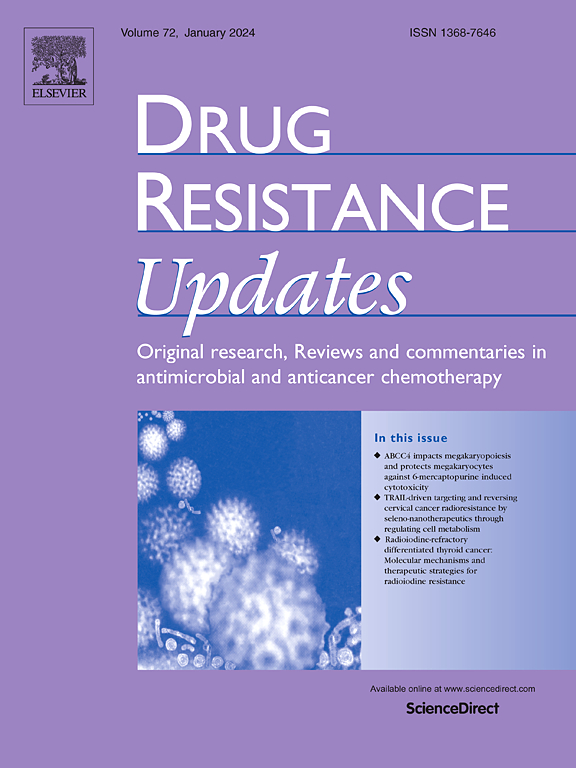利用小分子动态抑制剂通过劫持新生和诱导成熟ABCG2在溶酶体中降解的周转来克服多药耐药
IF 21.7
1区 医学
Q1 PHARMACOLOGY & PHARMACY
引用次数: 0
摘要
ABCG2与多药耐药(MDR)和癌症干细胞的保护有关。敲除ABCG2对小鼠无明显不良影响。因此,ABCG2是一个有趣的,也许是一个理想的药物发现靶点,以克服耐多药和消除癌症干细胞。虽然已经发现了许多ABCG2抑制剂,但很少进入临床试验,也没有一个获得批准。因此,对新型ABCG2抑制剂的需求尚未得到满足。利用蛋白水解靶向嵌合体(PROTAC)和分子胶进行靶向蛋白降解(TPD)已经获得了许多临床试验的关注,代表了一种靶向细胞质蛋白的新方法。然而,用于膜蛋白的TPD制剂很少。近年来,研究人员发现ABCG2抑制剂不仅能抑制ABCG2活性,还能诱导ABCG2降解。这些动态抑制剂是独特的,可能代表了一类新的膜蛋白TPD药物和下一代抑制剂的开发。在这里,我们研究了动态抑制剂PZ-39及其类似物PZ-39C8的作用机制,发现它们选择性地结合到ABCG2的TM5-TM6之间的细胞外环上。这种结合诱导成熟的ABCG2依赖于网格蛋白的内吞作用,并劫持新生的ABCG2,通过自噬将它们靶向溶酶体进行降解。PZ-39还能有效诱导ABCG2丢失,并使异种移植肿瘤的阿霉素耐药增敏。因此,对动态ABCG2抑制剂的进一步研究可能会导致下一代治疗药物克服癌症化疗中的耐多药,并有助于未来设计靶向膜蛋白的TPD药物。本文章由计算机程序翻译,如有差异,请以英文原文为准。
Overcoming multidrug resistance using small molecule dynamic inhibitors by hijacking nascent and inducing turnover of mature ABCG2 for degradation in lysosomes
ABCG2 has been associated with multidrug resistance (MDR) and protection of cancer stem cells. ABCG2 knockout had no apparent adverse effect on mice. Thus, ABCG2 is an interesting and perhaps an ideal target for drug discovery to overcome MDR and eliminate cancer stem cells. Although many ABCG2 inhibitors have been identified, few have moved into clinical testing and none has been approved. Thus, there is an unmet need for novel ABCG2 inhibitors. Targeted protein degradation (TPD) using proteolysis-targeting chimeras (PROTAC) and molecular-glues have been gaining traction with many in clinical trials, representing a new way targeting cytosolic proteins. However, TPD agents for membrane proteins are scarce. Recently, ABCG2 inhibitors with dynamic properties have been identified that they not only inhibit ABCG2 activity but also induce ABCG2 degradation. These dynamic inhibitors are unique and may represent a new class of TPD agents for membrane proteins and next generation inhibitors for development. Here, we investigated the mechanism of action of the dynamic inhibitor PZ-39 and its analogue PZ-39C8 and showed that they selectively bound to the extracellular loop between TM5-TM6 of ABCG2. This binding induces clathrin-dependent endocytosis of mature ABCG2 and hijacks nascent ABCG2, targeting them to lysosome via autophagy for degradation. PZ-39 also effectively induced ABCG2 loss and sensitized doxorubicin resistance in xenograft tumors. Thus, further investigation of dynamic ABCG2 inhibitors may lead to the next generation of therapeutics to overcome MDR in cancer chemotherapy and contribute to future design of TPD agents targeting membrane proteins.
求助全文
通过发布文献求助,成功后即可免费获取论文全文。
去求助
来源期刊

Drug Resistance Updates
医学-药学
CiteScore
26.20
自引率
11.90%
发文量
32
审稿时长
29 days
期刊介绍:
Drug Resistance Updates serves as a platform for publishing original research, commentary, and expert reviews on significant advancements in drug resistance related to infectious diseases and cancer. It encompasses diverse disciplines such as molecular biology, biochemistry, cell biology, pharmacology, microbiology, preclinical therapeutics, oncology, and clinical medicine. The journal addresses both basic research and clinical aspects of drug resistance, providing insights into novel drugs and strategies to overcome resistance. Original research articles are welcomed, and review articles are authored by leaders in the field by invitation.
Articles are written by leaders in the field, in response to an invitation from the Editors, and are peer-reviewed prior to publication. Articles are clear, readable, and up-to-date, suitable for a multidisciplinary readership and include schematic diagrams and other illustrations conveying the major points of the article. The goal is to highlight recent areas of growth and put them in perspective.
*Expert reviews in clinical and basic drug resistance research in oncology and infectious disease
*Describes emerging technologies and therapies, particularly those that overcome drug resistance
*Emphasises common themes in microbial and cancer research
 求助内容:
求助内容: 应助结果提醒方式:
应助结果提醒方式:


